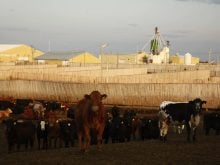This cattle market information is selected from the weekly report from Canfax, a division of the Canadian Cattle Association. More market information, analysis and statistics are available by becoming a Canfax subscriber by calling 403-275-5110 or at www.canfax.ca.
Fed market steady
The Alberta fed market maintained a steady tone last week. Fed steers and heifers have averaged in the low $240s per hundredweight over the past six weeks. This is about $10 per cwt. stronger than the same period last year.
Read Also

Huge Black Sea flax crop to provide stiff competition
Russia and Kazakhstan harvested huge flax crops and will be providing stiff competition in China and the EU.
Dressed sales were reported between $403-$405 per cwt. delivered, trading $2-$3 per cwt. lower than the previous week.
Canadian fed cattle and cow exports to the United States for the week ending Oct. 5 totalled 12,729 head, up 25 per cent from last year. Year to date, fed cattle and cow exports are up 18 per cent from last year. Over the last six weeks, there have been smaller weekly export volumes than last year.
Western Canadian fed slaughter for the week ending Oct. 12 was 40,373 head, down one per cent from last year. Since mid-May, weekly western Canadian fed slaughter has been below the five-year average.
Ontario fed prices have held steady in the low $240s per cwt. for the past six weeks. Dressed sales were reported at $406 per cwt. delivered, fully steady with the previous week.
In the U.S., trade in Texas ranged from US$187-$188 per cwt. Kansas was at $188 per cwt. Southern trade was $1-$2 per cwt. stronger than the previous week. Trade in the north was also $187-$188 per cwt. live and $296 per cwt. dressed. Live and dressed northern trade was fully steady with the previous week.
Last week’s U.S. kill was estimated at 608,000 head, 20,000 head more than the previous week. Year-to-date fed slaughter, at 19.3 million head, is 0.7 per cent smaller than last year and 2.7 per cent smaller than the five-year average.
Steer carcass weights averaged 950 pounds in the first week of October, which was the heaviest weekly average on record. Year to date, steer carcass weights averaged 923 lb., 24 lb. heavier than last year and 28 lb. heavier than the five-year average.
Steady cow trade
Alberta cows traded steady through commercial auction facilities while eastern Canadian cow prices rebounded $5 per cwt. following seven consecutive weeks of lower prices. In Western Canada, non-fed volumes continued to be much lighter than normal for this time of year.
Feeder cow buyers and major packers continue to be active on the market. Cows that are put on feed now are likely going to target the Christmas/New Year market.
Alberta D2 cow prices are averaging in the mid to upper $170s per cwt., $45 per cwt. higher than last year. Last week, they averaged $177 per cwt. and D3s averaged $163.72. Slaughter bulls averaged $196.53 per cwt.
For the week ending Oct. 12, Western Canadian cow slaughter totalled slightly more than 4,400 head, 36 per cent below last year. For the first half of October, this is the smallest slaughter since 2015. Slaughter volumes are expected to stay below last year for the balance of this year.
Lower non-fed beef production expected for the fourth quarter will continue to support overseas beef imports. From their highs in August, butcher bull prices have declined $21 per cwt.
Cutouts rally
In U.S. beef trade, cutouts rallied higher for the second consecutive week. Choice ended the week three per cent higher to US$319.26 per cwt. Select moved one per cent higher to $293.52 per cwt.
Fall run under way
The fall calf run is in full gear, and prices continue to hold up well. The calf market has experienced a counter-seasonal move higher, considering prices historically don’t strengthen from September to October.
Over the past 15 years, 550 lb. calf prices have only strengthened from September to October five times. In those years, September stood as the low and prices strengthened throughout the fall.
Based on AFSC data, for the first two weeks in October, Saskatchewan and Manitoba steer calves traded at roughly a $4 per cwt. premium against the Alberta markets.
Last week, the only class of cattle to set new all-time highs was Alberta 300-400 lb. steer and heifer calves. In certain spots, grass buyers have been active on lightweight calves. There are still quite a few grass yearlings trading through auction facilities and via electronic/video sales for this time of the year.
Heavier weight feeder prices have not rallied to the same degree as the calf market. Over the past month, heavier weight feeder prices have been moving sideways.
Last week, Alberta and Saskatchewan steers weighing 750-850 lb. for late January/early February delivery traded on either side of $355 per cwt.
















